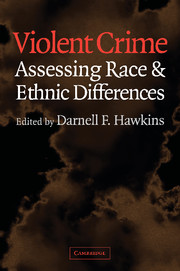Book contents
- Frontmatter
- Contents
- Contributors
- Foreword
- Editor's Introduction
- Violent Crime
- Part I Homicide Studies
- Part II Other Contexts, Settings, and Forms of Violence
- 6 Sanction Effects, Violence, and Native North American Street Youth
- 7 Ethnicity and Interpersonal Violence in a New Zealand Birth Cohort
- 8 Racist Victimization in England and Wales
- 9 Race, Gender, and Woman Battering
- 10 Gender Entrapment and African-American Women: An Analysis of Race, Ethnicity, Gender, and Intimate Violence
- Part III Explaining Racial and Ethnic Differences
- References
- Index
10 - Gender Entrapment and African-American Women: An Analysis of Race, Ethnicity, Gender, and Intimate Violence
Published online by Cambridge University Press: 22 August 2009
- Frontmatter
- Contents
- Contributors
- Foreword
- Editor's Introduction
- Violent Crime
- Part I Homicide Studies
- Part II Other Contexts, Settings, and Forms of Violence
- 6 Sanction Effects, Violence, and Native North American Street Youth
- 7 Ethnicity and Interpersonal Violence in a New Zealand Birth Cohort
- 8 Racist Victimization in England and Wales
- 9 Race, Gender, and Woman Battering
- 10 Gender Entrapment and African-American Women: An Analysis of Race, Ethnicity, Gender, and Intimate Violence
- Part III Explaining Racial and Ethnic Differences
- References
- Index
Summary
Introduction
In other chapters of this volume and elsewhere, researchers have reviewed national and local data, which reveal the serious and complex societal problems, which result from high rates of interpersonal violence. They also have documented the extent of racial and ethnic disparity for both victimization and offending. Among the varied forms of interpersonal aggression, intimate violence, particularly violence against women, has now clearly been shown to be a significant and persistent social problem that may result in death and has serious consequences for individuals, their families, and society as a whole (Dobash, 1992; Crowell and Burgess, 1996; U.S. Department of Justice, 1997; FBI, 1995; Stark and Flitcraft, 1996).
According to the Bureau of Justice Statistics and the FBI, between 1992 and 1996, there were more than 960,000 documented violent victimizations of women by an intimate partner. This figure includes aggravated and simple assaults, rape and sexual abuse, murder, and robbery (Bureau of Justice Statistics, 1996, 1997a). The average rate for this period was eight violent victimizations per one thousand women, which represents a decline from 10 per 1,000 in 1993 to 7.5 in 1996. An assessment of lethal violence for 1996 indicates that 1,800 murders (approximately 9 percent of the total) were attributable to intimates, and in nearly three out of four of these crimes, the victim was female.
- Type
- Chapter
- Information
- Violent CrimeAssessing Race and Ethnic Differences, pp. 198 - 210Publisher: Cambridge University PressPrint publication year: 2003
- 11
- Cited by



